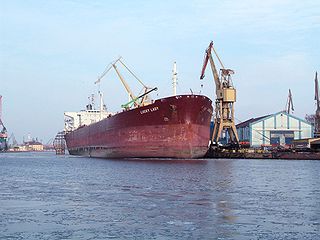At common law, damages are a remedy in the form of a monetary award to be paid to a claimant as compensation for loss or injury. To warrant the award, the claimant must show that a breach of duty has caused foreseeable loss. To be recognized at law, the loss must involve damage to property, or mental or physical injury; pure economic loss is rarely recognized for the award of damages.
Negligence is a failure to exercise appropriate care expected to be exercised in similar circumstances.
In law and insurance, a proximate cause is an event sufficiently related to an injury that the courts deem the event to be the cause of that injury. There are two types of causation in the law: cause-in-fact, and proximate cause. Cause-in-fact is determined by the "but for" test: But for the action, the result would not have happened. The action is a necessary condition, but may not be a sufficient condition, for the resulting injury. A few circumstances exist where the but-for test is ineffective. Since but-for causation is very easy to show, a second test is used to determine if an action is close enough to a harm in a "chain of events" to be legally valid. This test is called proximate cause. Proximate cause is a key principle of insurance and is concerned with how the loss or damage actually occurred. There are several competing theories of proximate cause. For an act to be deemed to cause a harm, both tests must be met; proximate cause is a legal limitation on cause-in-fact.
A tort is a civil wrong that causes a claimant to suffer loss or harm, resulting in legal liability for the person who commits the tortious act. Tort law can be contrasted with criminal law, which deals with criminal wrongs that are punishable by the state. While criminal law aims to punish individuals who commit crimes, tort law aims to compensate individuals who suffer harm as a result of the actions of others. Some wrongful acts, such as assault and battery, can result in both a civil lawsuit and a criminal prosecution in countries where the civil and criminal legal systems are separate. Tort law may also be contrasted with contract law, which provides civil remedies after breach of a duty that arises from a contract. Obligations in both tort and criminal law are more fundamental and are imposed regardless of whether the parties have a contract.

English tort law concerns the compensation for harm to people's rights to health and safety, a clean environment, property, their economic interests, or their reputations. A "tort" is a wrong in civil law, rather than criminal law, that usually requires a payment of money to make up for damage that is caused. Alongside contracts and unjust enrichment, tort law is usually seen as forming one of the three main pillars of the law of obligations.

Overseas Tankship (UK) Ltd v The Miller Steamship Co or Wagon Mound , is a landmark tort case, concerning the test for breach of duty of care in negligence. The Judicial Committee of the Privy Council held that loss will be recoverable where the extent of possible harm is so great that a reasonable man would guard against it.
Causation is the "causal relationship between the defendant's conduct and end result". In other words, causation provides a means of connecting conduct with a resulting effect, typically an injury. In criminal law, it is defined as the actus reus from which the specific injury or other effect arose and is combined with mens rea to comprise the elements of guilt. Causation only applies where a result has been achieved and therefore is immaterial with regard to inchoate offenses.
In English tort law, an individual may owe a duty of care to another, in order to ensure that they do not suffer any unreasonable harm or loss. If such a duty is found to be breached, a legal liability will be imposed upon the tortfeasor to compensate the victim for any losses they incur. The idea of individuals owing strangers a duty of care – where beforehand such duties were only found from contractual arrangements – developed at common law, throughout the 20th century. The doctrine was significantly developed in the case of Donoghue v Stevenson, where a woman succeeded in establishing a manufacturer of ginger beer owed her a duty of care, where it had been negligently produced. Following this, the duty concept has expanded into a coherent judicial test, which must be satisfied in order to claim in negligence.
Causation in English law concerns the legal tests of remoteness, causation and foreseeability in the tort of negligence. It is also relevant for English criminal law and English contract law.
In English law, remoteness between a cause of action and the loss or damage sustained as a result is addressed through a set of rules in both tort and contract, which limit the amount of compensatory damages available for a wrong.

In RePolemis & Furness, Withy & Co Ltd (1921) is an English tort case on causation and remoteness in the law of negligence.

Overseas Tankship (UK) Ltd v Morts Dock and Engineering Co Ltd, commonly known as Wagon Mound , is a landmark tort law case, which imposed a remoteness rule for causation in negligence. The Privy Council held that a party can be held liable only for loss that was reasonably foreseeable. Contributory negligence on the part of the dock owners was also relevant in the decision, and was essential to the outcome, although not central to this case's legal significance.
Economic loss is a term of art which refers to financial loss and damage suffered by a person which is seen only on a balance sheet and not as physical injury to person or property. There is a fundamental distinction between pure economic loss and consequential economic loss, as pure economic loss occurs independent of any physical damage to the person or property of the victim. It has also been suggested that this tort should be called "commercial loss" as injuries to person or property can be regarded as "economic".

Spartan Steel & Alloys Ltd v Martin & Co (Contractors) Ltd [1973] QB 27 is a well-known English Court of Appeal case concerning the recovery of pure economic loss in negligence.

Royscot Trust Ltd v Rogerson[1991] EWCA Civ 12 is an English contract law case on misrepresentation. It examines the Misrepresentation Act 1967 and addresses the extent of damages available under s 2(1) for negligent misrepresentation.
Smith v Leech Brain & Co [1962] 2 QB 405 is a landmark English tort law case in negligence, concerning remoteness of damage or causation in law. It marked the establishment of the eggshell skull rule, the idea that an individual is held responsible for the full consequences of his negligence, regardless of extra, or special damage caused to others.

The eggshell rule is a well-established legal doctrine in common law, used in some tort law systems, with a similar doctrine applicable to criminal law. The rule states that, in a tort case, the unexpected frailty of the injured person is not a valid defense to the seriousness of any injury caused to them.
Fourway Haulage SA (Pty) Ltd v SA National Roads Agency Ltd is an important case in South African law. It was heard in the Supreme Court of Appeal on 5 November 2008, with judgment handed down on 26 November. The judges were Scott JA, Farlam JA, Brand JA, Lewis JA and Jafta JA. JH Dreyer SC appeared for the appellant, and AC Ferreira SC for the respondent.

Attorney-General v Geothermal Produce New Zealand Ltd [1987] 2 NZLR 348 Is an important case in New Zealand regarding cases involving negligence, more specifically regarding foreseeability of loss and the duty to mitigate loss.

Clearlite Holdings Ltd v Auckland City Corp [1976] 2 NZLR 729 is a cited case in New Zealand regarding land based nuisance claims in tort.







